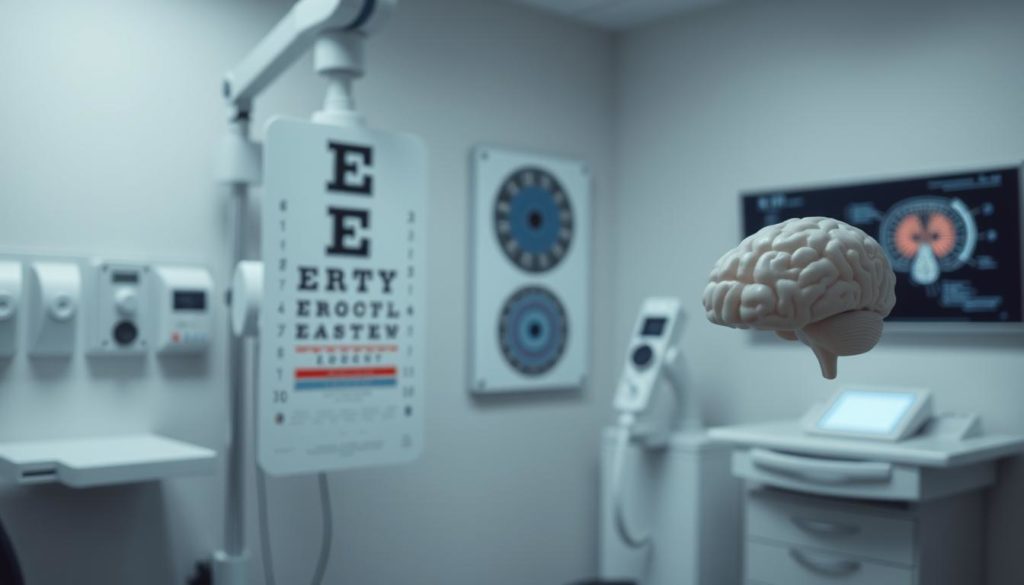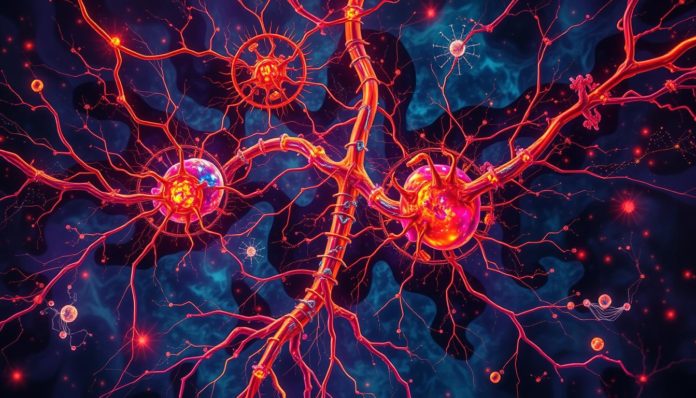“The greatest wealth is health.” – Virgil
Virgil’s words are especially true when it comes to Neuromyelitis Optica symptoms. This condition, also known as Devic’s disease, is very serious. It causes damage to the brain and spinal cord because of the immune system.
It’s important to know the signs of NMO because it can look like other diseases. This makes it hard to diagnose.
Knowing the signs of Neuromyelitis Optica can help a lot. It can mean getting a diagnosis sooner. This article will help you understand what to look for.
What is Neuromyelitis Optica?
Neuromyelitis Optica (NMO) is a rare disease that mainly affects the optic nerves and spinal cord. Knowing the Signs of Neuromyelitis Optica is key for early treatment. Let’s explore what NMO is and how it differs from other conditions.
Definition of Neuromyelitis Optica
NMO, also known as Devic’s disease, causes inflammation in the optic nerve and spinal cord. This can lead to sudden blindness and paralysis. Unlike multiple sclerosis (MS), NMO often hits these areas harder and more severely.

Difference Between NMO and MS
The Neuromyelitis Optica vs. Multiple Sclerosis debate is important because of their differences. Both are demyelinating diseases, but NMO is more aggressive. It involves a specific antibody, AQP4-IgG, which targets aquaporin-4 water channels, unlike MS.
Knowing these differences helps doctors create better treatment plans. These plans aim to reduce relapses and improve patient outcomes.
Early Signs of Neuromyelitis Optica
Spotting the early signs of Neuromyelitis Optica (NMO) is key to catching it early. This can lead to better treatment and outcomes. Catching NMO symptoms early can stop long-term damage.
Vision Issues
Vision problems are often the first sign of NMO. Patients might suddenly lose vision or see things blurry. Catching these vision issues early can help save eyesight.
Numbness and Tingling

Numbness and tingling in the arms or legs are also early signs. These feelings show that the nerves are being affected. Paying attention to these signs can help get medical help sooner.
| NMO Early Symptom | Description |
|---|---|
| Vision Issues | Sudden blindness or blurred vision episodes |
| Numbness and Tingling | Sensations in extremities, often starting in arms or legs |
Neuromyelitis Optica Symptoms
Neuromyelitis Optica symptoms can vary a lot, making it hard to diagnose. Common symptoms include severe muscle weakness, eye pain, and sometimes paralysis. Catching these symptoms early is key to managing the condition.
Patients experience different symptoms, like chronic pain or sudden episodes. The symptoms can change over time, leading to periods of better health followed by worse episodes.
Some people have trouble seeing because of optic neuritis, a key sign of Neuromyelitis Optica. This can cause blurry vision, eye pain, or even loss of sight. Muscle weakness, especially in arms and legs, can also make daily tasks hard. Finding symptoms early helps manage them better.
Neuromyelitis Optica also affects patients’ mental health. The unpredictable symptoms can cause anxiety and stress, impacting their quality of life.
Here’s a table showing the symptoms people with Neuromyelitis Optica might have:
| Symptom | Description |
|---|---|
| Visual Disturbances | Blurry vision, eye pain, or vision loss due to optic neuritis. |
| Muscle Weakness | Weakness especially in the limbs, affecting mobility and daily tasks. |
| Paralysis | Complete or partial paralysis of certain muscle groups. |
| Chronic Pain | Persistent pain that can range from mild to severe. |
| Ocular Pain | Severe pain in one or both eyes, often accompanying vision problems. |
It’s important for doctors to understand and spot Neuromyelitis Optica symptoms. This helps them create a good plan to manage the condition and improve patients’ lives.
Clinical Manifestations of Neuromyelitis Optica
The symptoms of Neuromyelitis Optica can vary but often include optic neuritis and transverse myelitis. These symptoms can cause severe vision loss and spinal cord inflammation. They greatly affect patients’ lives.
Optic Neuritis
Optic neuritis is a tough symptom of NMO. It can cause a lot of vision loss or even complete blindness. Patients often feel eye pain when moving their eyes and see things less clearly.
This inflammation of the optic nerve is a key sign of Neuromyelitis Optica. Finding it early is very important.
Transverse Myelitis
Transverse myelitis is another big symptom. It causes spinal cord inflammation. This leads to paralysis, sensory loss, and problems with the bladder or bowel.
The inflammation affects the spinal cord, disrupting normal nerve pathways. This causes severe functional problems.
Other Neurological Symptoms
Neuromyelitis Optica can also cause nausea, vomiting, and hiccups. This is because of inflammation in certain brain areas. Patients might also have muscle weakness and poor coordination.
Understanding these symptoms is crucial for managing and treating NMO.
| Symptom | Description |
|---|---|
| Optic Neuritis | Painful vision loss due to optic nerve inflammation. |
| Transverse Myelitis | Spinal cord inflammation leading to paralysis and sensory loss. |
| Other Neurological Symptoms | Nausea, vomiting, muscle weakness, and reduced coordination. |
Diagnostic Indicators of Neuromyelitis Optica
Finding Neuromyelitis Optica (NMO) can be tough. That’s why the right signs are key for quick treatment. This part talks about the tools and tests used to spot it.
One major sign of NMO is NMO-IgG antibodies in the blood. Tests for NMO look for these antibodies. This makes finding NMO more accurate. Here’s a look at the different signs used to spot NMO:
| Diagnostic Indicator | Utilization | Importance |
|---|---|---|
| NMO-IgG Antibodies | NMO Blood Tests | High |
| MRI Findings | Differentiating NMO from MS | Medium |
| Clinical Symptoms Analysis | Initial Assessment | Low |
MRI scans are very important in diagnosing NMO. They help tell NMO apart from other diseases like Multiple Sclerosis (MS). MRI scans show signs like long stretches of myelitis and certain optic neuritis patterns.
Getting a correct and early diagnosis is crucial for better care in Neuromyelitis Optica. These signs are vital for doctors to help their patients.
Warning Signs to Look Out For
Knowing the Neuromyelitis Optica warning signs is key for early treatment. This part talks about two main signs to watch for.
Fatigue
One big sign is NMO fatigue. It’s not just feeling tired. It’s a deep, lasting exhaustion that doesn’t get better with rest. People often struggle with everyday tasks, affecting their life quality.
Spotting NMO fatigue early is important for managing the condition well.
Bladder and Bowel Dysfunction
Bladder and bowel control issues are also warning signs. Problems can include incontinence or retention, making life hard. It’s vital for patients to understand these issues.
Early action can help avoid big problems. Here’s a table showing common bladder and bowel issues in NMO:
| Type of Dysfunction | Bladder Control Issues | Bowel Control Issues |
|---|---|---|
| Incontinence | Loss of bladder control leading to leakage | Inability to control bowel movements |
| Retention | Inability to empty the bladder completely | Difficulty in passing stools |
By spotting these signs early, people can get the right help. They can also find ways to manage their symptoms better.
Understanding the Impact on Daily Life
Living with NMO brings daily challenges. People face issues like mobility problems, vision loss, and constant tiredness. These problems need big changes in lifestyle and lots of support.
Mobility issues make simple tasks hard. People might need canes, walkers, or wheelchairs to get around. Vision problems add to the struggle, making everyday tasks harder to do alone.
The emotional side of NMO is just as tough. Those with NMO often feel frustrated, anxious, and sad. Getting help for mental health is key to staying positive.
Making these changes requires both practical and emotional steps. Some ways to adapt include:
- Changing the home to make it easier to get around.
- Taking breaks to fight off tiredness.
- Looking for support groups and counseling.
Knowing all about NMO helps manage it better. It also builds a stronger community for those with NMO.
Advanced Symptoms of Neuromyelitis Optica
Neuromyelitis Optica (NMO) can lead to serious symptoms that change patients’ lives. It’s important to spot these symptoms early and manage them well. This helps keep a good quality of life.
Chronic Pain
Chronic pain is a big challenge for NMO patients. They often feel different levels of pain that make daily tasks hard. It’s key to manage NMO pain well to feel better.
Treatments include medicines, physical therapy, and even acupuncture. A plan made just for the patient can greatly improve their life.
Mobility Issues
As NMO gets worse, moving around becomes harder. Patients might find it tough to walk, balance, and coordinate. This makes them rely more on devices like canes and wheelchairs.
These tools help them stay independent and safe. Occupational therapy also helps them adjust their homes and routines to these changes.
It’s vital to tackle these advanced symptoms to improve life for NMO patients. By using specific pain management and adaptive devices, they can face the condition’s challenges better.
FAQ
What is Neuromyelitis Optica?
Neuromyelitis Optica, or NMO, is a chronic disease that affects the brain and spinal cord. It’s caused by an immune response that damages the protective covering of nerve fibers. Knowing the symptoms is key to getting the right treatment.
How is NMO different from Multiple Sclerosis (MS)?
NMO and MS are both autoimmune diseases but affect the central nervous system differently. NMO mainly hits the optic nerves and spinal cord. MS can affect many parts of the brain and spinal cord. Knowing the difference is important for treatment.
What are the early signs of Neuromyelitis Optica?
Early signs include sudden vision problems like blindness or blurriness. You might also feel numbness or tingling in your limbs. Spotting these signs early can prevent serious damage.
What are some common symptoms of Neuromyelitis Optica?
Common symptoms include severe muscle weakness and eye pain. Some people may even experience paralysis. The symptoms can change in severity, making it important to understand them for treatment.
What clinical manifestations are associated with Neuromyelitis Optica?
Key symptoms include optic neuritis, which can cause vision loss, and transverse myelitis, leading to spinal cord inflammation and paralysis. Knowing these symptoms helps understand the disease’s impact.
How is Neuromyelitis Optica diagnosed?
Doctors use blood tests for NMO-IgG antibodies and MRI scans to diagnose NMO. Early and accurate diagnosis is vital for better treatment outcomes.
What are some warning signs to look out for in Neuromyelitis Optica?
Warning signs include persistent fatigue and problems with bladder and bowel control. Recognizing these signs can help manage the disease better.
How does Neuromyelitis Optica impact daily life?
NMO can make everyday tasks hard due to mobility and vision issues. Understanding these effects is key to managing the disease effectively.
What are the advanced symptoms of Neuromyelitis Optica?
Advanced symptoms include chronic pain and significant mobility problems. Managing pain and using adaptive devices is crucial in these stages.


